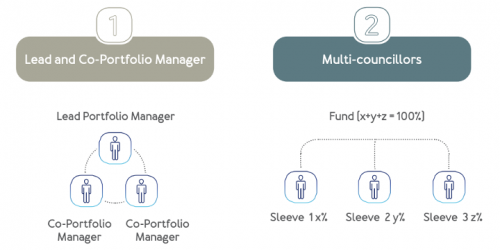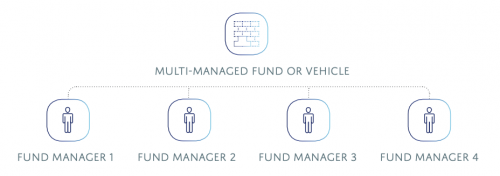Manager Insights
Decoding the Decision-Making of Investment Managers

Selecting a fund…do not forget how decisions are made
Selecting investment funds can be a daunting task given the numerous options available. There are more than 1 700 Collective Investment Schemes (CISs) to choose from in South Africa and more than 135 000 mutual funds globally. Even if investors are aided by their financial advisers in narrowing down the opportunity set through risk and needs analysis, there can still be numerous options to choose from.
The investment managers that run these portfolios have different philosophies and processes, which translate into specific approaches towards decision-making. One important aspect of managing money relates to how investment decisions are made.Although this may not always be known to the man in the street, it will have implications and may influence the future performance outcome of an investment manager.
As a DFM, we seek to identify high quality funds and blend them to give investors the best opportunity to achieve their investment goals. This includes unpacking the decision-making approaches of managers and assessing whether it adds or detracts from the final rating allocated to the manager.
In this article we provide insights into the benefits and pitfalls of the various decision-making approaches. The graphics that follow practically illustrate the differences between the various investment decision-making approaches.
The trend towards collective decision-making
A crucial part of our qualitative assessment of an investment manager is to delve deeply into the investment team, going beyond the assessment of investment experience. We get to the heart of how the investment team is set up for idea generation, analysis discussion and how this leads to the ultimate security selection – stocks and bonds – that ends up in the manager’s portfolio. Over time, we have observed that investment managers have trended away from a ‘star’ portfolio manager mentality to a collective decision-making approach in varying degrees.
Single manager…decision-making approaches
Within a single fund manager, the two distinct approaches to collective investment decisions are:

Within a co-portfolio manager structure, the lead portfolio manager, who has ultimate accountability, is supported by other portfolio managers who bring forth ideas and analysis, which are then considered by the entire team. The benefits to this are that it reduces key man risk and there is likely better diversity in the ideas and the analysis can be more robust since each co-portfolio manager can watch out for one another’s blind spots.
Having a good team culture with robust debate encourages equal participation and contribution from all members of the investment team and is a crucial success factor for collaborative decision making. In addition to having shared responsibility for the assets under management, co-portfolio managers may have the ability to cover more market opportunities and to assess investment ideas.
In interrogating co-portfolio manager structures, we watch out for dogmatic behaviour from the lead portfolio manager. We also look out for the risk of groupthink that can emerge from this approach. Groupthink occurs when individuals within the group prioritise consensus over critical thinking and independent judgment, resulting in flawed decision-making. Furthermore, we assess the investment manager’s governance structures that measure and hold each person accountable for their contributions. A potential drawback of this structure is that it can be timeconsuming and inefficient, especially in the context of having to make investment decisions during volatile market conditions. We evaluate how co-portfolio managers mitigate these risks and effectively manage conflict and communication.
Single manager: multi-councillor
Like co-portfolio managers, the multi-councillor approach also has the benefits of diverse views and ideas being considered within a portfolio, but the mechanism works differently. A multi-councillor approach involves a portfolio with allocations to individual portfolio managers from the same team, who manage a sleeve or percentage of the overall portfolio. While the team shares insights and collaborate, each councillor implements their highest conviction views and clients receive a blended portfolio with all the individual portfolio manager views being incorporated. Benefits to this type of approach include each councillor’s views being assessed by the other councillors for ideas or as feedback to the investment process.
Another benefit is the potential mechanism it creates for transitioning analysts to portfolio managers in a deliberate way, supporting incentivisation and retaining investment talent. A drawback of the multi-councillor approach is that it can result in over-diversification and the amalgamated portfolio looking like the benchmark. This limits the potential for outperformance. Another pitfall of the multi-councillor approach is that the disclosure of individual councillor’s portfolio performances is generally not shared and when there is a change of councillors, it is difficult to pin-point the reasons for the change.
DFM and/or multi-manager decision-making approach
A DFM investment approach is where a single investment vehicle – such as a fund – invests in multiple underlying investment managers or strategies. There are several advantages to a multi-managed strategy such as diversification, access to specialised managers, and simplification. Diversification benefits arise when the DFM invests in a range of other investment funds so that the investor gains exposure to different investment styles and the overall fund performance is not impacted by a single manager. This helps to reduce the overall risk of the portfolio and should deliver a more stable return over time. DFMs also have access to a wide variety of specialised managers and can customise mandates with underlying managers to suit the overall fund objectives. Managers within the underlying multi-managed fund are closely monitored by the DFM, who has regular engagement with underlying fund managers to ensure that they are on track to meet their individual objectives. Direct retail clients in an underlying fund are limited in terms of this access and report backs.
Another approach called best of breed, is where a multi-manager who has a variety of funds defined by various asset classes/mandates and only one manager is allocated within each fund. Therefore, in a best of breed approach the investor only has exposure to a single fund and the decision making set up of that fund i.e., one star portfolio manager, co-portfolio manager or multi-councillor. However, best of breed still has the benefit of a multi-manager who closely monitors the underlying fund manager and has the discretion to replace that underlying fund.
Do not confuse DFM/multi-manager with multi-councillor
Multi-manager and multi-councillor may sound similar, but the key difference is that in a DFM/multi-managed fund, the client is getting exposure to variety of manager styles and different decision-making approaches.
Approach 1: Multiple funds selected

Various investment approaches can be used
i.e individual portfolio, co-portfolio manager or multi-councillor
The multi-councillor approach is where the councillors are from the same investment manager and typically use a common buy-list and align their stock or security selection to the overall investment manager’s investment philosophy, approach, and process. Therefore, the degree of diversification from adopting a multi-councillor approach is limited to only one investment house and the degree to which councillors differ in terms of the final stock selection and level of conviction. Furthermore, there are many other house and investment considerations that contribute to ‘single fund risk’, which is not diversified by a multi-councillor approach.
Approach 2: Best of Breed

No ideologies when it comes to decision-making approaches
The primary role of a DFM is to assist investors to diversify ‘single fund risk’. We also understand that even good fund managers go through periods of underperformance and a multi-managed approach is likely to deliver a more consistent outcome over time, given its diverse exposure to good managers. When blending these managers, one of our objectives is to reduce the impact of individual bias.
Whether investment managers use an individual portfolio manager, coportfolio, or multi-councillor approach to make decisions, we seek to identify bias that exists within investment managers. This bias could arise from the manager’s investment approach, or the experiences and backgrounds of the individual portfolio managers and analysts.
We strongly believe that investment ideologies should not dictate investment manager selection. As such, we do not prioritise any method – whether coportfolio or multi-councillor. Instead, we consider various factors when assessing a house, such as the expertise and competence of the individuals involved in analysis and the role individuals play.
Ultimately, our focus is to identify investment managers with the skill and ability to generate alpha in the future, based on a comprehensive evaluation of numerous factors, characteristics, interactions, and attributes. The investment decision-making approach is therefore key, only from the point of view that its works well for the particular investment manager and enables the manager’s philosophy and process to deliver the best potential investment outcomes.
Key Points:
• Investment decision-making is a very important component of the manager selection process.
• Investment managers use various approaches to make decisions – from the use of an individual portfolio manager to co-portfolio or a multi-councillor approach.
• Although we have no ideologies when it comes to decision-making approaches, it is key that the approach adopted enables the manager’s philosophy and process for the best potential investment outcomes.
Knowledge is Power…
Access more insights from the INN8 Invest team’s quarterly report.
For you, the adviser, click below to download a collection of articles to use in your practice.
